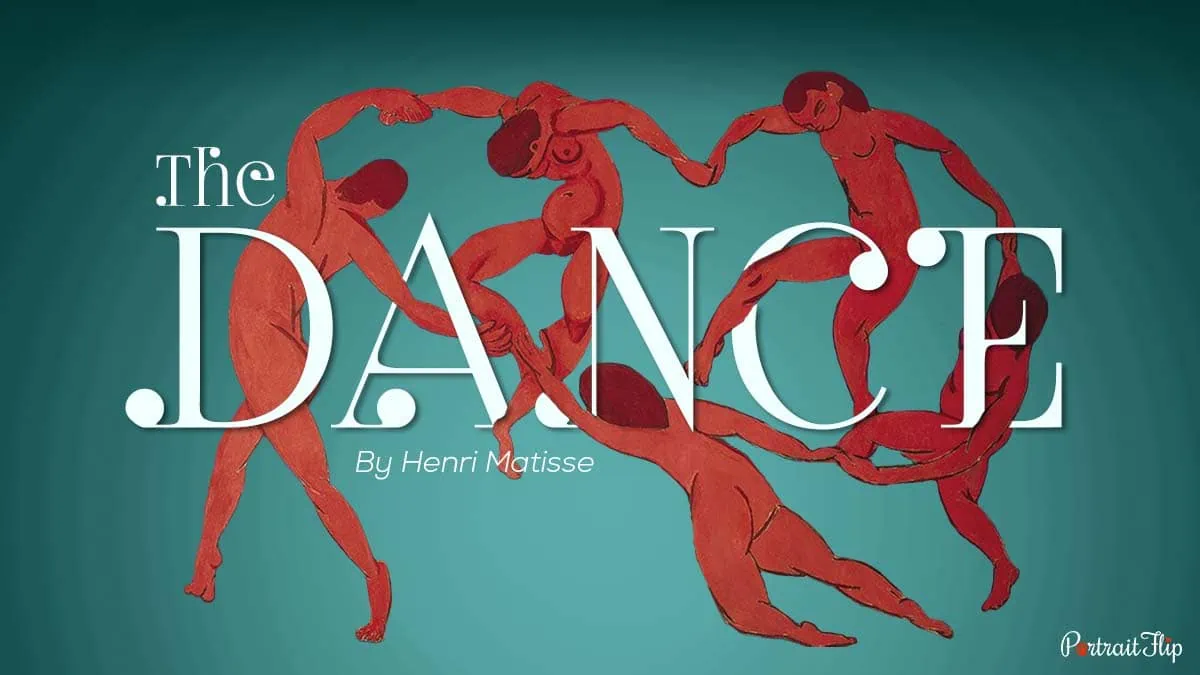Today my eyes fell on a weird yet amusing painting.
It showed a group of naked people dancing in a circle with uncanny expressions on their faces.
And suddenly, my mind was flooded with questions.
“Is the art promoting some kind of cult?” “What type of dance does the artist want to portray?”
The curiosity reached a level where I ended up writing about the artwork.
Have you heard about the painting “Dance by Henri Matisse” before?
The art portrays five figures holding each other’s hands as if they were dancing, which represents freedom and joy.
But there’s a lot to explore that can change the way you look at art.
In this blog, we’ll be discussing the ins and outs of this most creative artwork by Matisse, which is of course going to be a fun read.
But let’s first commence with the artist who gave us a reason to write!
Table of contents
About the Artist Henri Matisse

Who was Henri Matisse?
If I can reply in just a few words, then it would be the second Pablo Picasso!
He was the most outstanding colorist of the 20th century, with innovations compared to those of Picasso.
Matisse was also counted among the famous French and Expressionist artists.
He was a leading pillar of Fauvism and was recognized as the head of the French movement.
There were two reasons why he created the dance painting:
First, Matisse once said that he wanted to create a piece of work that’d leave a soothing effect on the inner soul of the viewer. Just like a smooth and nice couch.
His viewers would feel contentment after witnessing his work.
The second reason was Sergei Shchukin, a Russian businessman and art patron who was also a close admirer of Henri’s work.
During the year 1910, he commissioned Matisse two large decorative panels for his Trubetskoy Palace.

Yes, there were two “Dance by Matisse.”
One was created in 1910 and the other was produced in 1932 with red figures.
Still life and naked figures were two beloved subjects of Matisse. Let’s admire both!
Explaining Matisse Dance Paintings
Imagine your are in front of the dancing circle painting.
What is the first thought that would cross your mind?
Group of nude figures standing in a circle, right?
It is fair to say that the first thing one would see is a naked human.
After seeing its title, dance could be the next thing in line that they’d admire. Do you know why?
The composition has always seen first due to its colors and details.
Also, the art reveals the basic structure of representational art (humans).
How about we start with the first creation of the dance painting?
Matisse’s Dance Art

| Created In | 1910 |
| Version | 1st Dance Painting |
| Medium | Oil on Canvas |
| Currently Located | The Hermitage, St. Petersburg |
The image you notice above is the first “Dance” by Henri Matisse.
Skin-colored humans dancing while holding hands in a circle—the details are the simplest one can ever look for, don’t you think?
This famous dance artwork admires the artist, who once defined it as an “overwhelming peak of brilliance.”
Do you know that the unclothed figures were never a call from Shchukin?
Sergei (the man who commissioned Henri) requested specifically for dancers depicted in costumes.
But Matisse had other thoughts already running through his mind.
It was his decision to represent the dancers in an undressed manner in order to illuminate a sensational view for the audience.
But you know that subjects like these were always brought into the light of criticism.
Henri was accused of suffering from a mental health issue due to the depiction of such a disgraceful picture.
However, it didn’t stop the painting from reaching out to people.
And as we all know, it became a massive success!
Now, let’s jump to the second Matisse dancer analysis, which you can say is identical to the first!
Matisse’s Dance Art II

| Created In | 1932 |
| Version | 2nd Dance Painting |
| Medium | Oil on Canvas |
| Currently Located | Barnes Foundation |
The figure in this art is as similar as in Matisse’s first dance artwork.
He created a similar pattern in art with the same title but with a slight difference, which is humans in red.
It took him two years to produce the piece, which completely exhausted him in both ways—physically and emotionally.
Matisse was deeply hurt after knowing that Barnes had no plan to showcase his painting in public.
He was euphoric about the art but the fact that it was not the choice for Barnes made him gloomy.
Some critics believe that Matisse Dance Painting II is significant as it reconnected him with the foundation of the art world.
I already mentioned how the painting conveys delight and glee to the people’s eyes in an effortless way.
The simplicity of the piece is definitely to die for.
Dance painting by Matisse also has a pendant art (a pair) named “Music (1910).”

This piece was created soon after The Dance by Matisse (1910) in order to complete Matisse’s dancing figures.
Did you notice one unusual thing about this art?
The figures are neither male nor female. I mean, just observe closely.
The body structure, the facial expression, the movement—all of them don’t indicate any specific gender.
What a masterpiece, I must say!
Don’t you think a masterpiece that illuminates a pleasing view surely deserves your wall?
Click on the link and witness the beauty of our replica paintings.
Creating Motion with Music: Texture of the Dance Painting

A question for you: Can you hear the music in the painting?
You must be wondering what a weird question this is. But look carefully.
Don’t these figures seem to synchronize at just one rhythm, at one beat, or at one tune?
The painting “Music” was not created just to pair it up with “Dance.”
Matisse was a genius. Do you know why?
The fact that there is no dance without music is loudly visible through the “Music” he painted.
It is interesting to analyse the dance in paintings with the artwork “Music” parallel to it.
Keeping the style simple and focusing on the theme, Henri’s art develops a sense of space and movement within dance.
Suggested read: Henri’s Woman with a Hat
Artworks that Influenced Dance by Matisse

People get inspired by various artworks in their lives.
Either it became their motivation to paint or their goal to achieve such excellence in their pieces.
Matisse was not far behind.
His fascination with dance started to grow with each piece of artwork that came into his life.
One of the paintings was “Oberon, Titania and Puck with Fairies Dancing by William Blake.”
Henri was intrigued by the little features that William’s painting offered.
If you look at the above image, the whole picture feels dreamy and gives a calm view to the eyes.
Another painting was “Les Demoiselles d’Avignon” by the famous Pablo Picasso.
You must have witnessed this art by Picasso before. Strange expressions of women figure-like subjects in unusual poses.
We already know the effect of Picasso on his life and now we know where the uncanny looks in the dance painting came from.
In 1906, Matisse created a piece that was inspired by the theme dance.
The painting was “Le bonheur de vivre (The Joy of Life).”

If you notice, the dancers far in the painting are in the same position as we observed in his “Dance” artwork.
Another belief is that Matisse’s obsession with dance started with “Moulin de la Galette,” where he observed people dancing and was fascinated by the culture.
Well, this theory was stated by Charles Caffin (an art critic), just like hundreds of people did in the past.
Conclusion: A Political Artwork
A political art? Let me walk you through this!
For years, the Dance by Matisse was housed in the lavish mansion of Shchukin.
But not for eternity!
Following the years, there was a raid on Shchukin’s home, where both paintings disappeared mysteriously.
It is also believed that in 1917, the artwork was seized by the state during the Russian Revolution.
Later, in 1930, the paintings reappeared and made their way to the museum of the Hermitage in Russia.
And as we all know, the paintings are still living on the walls of the same museum.
I know it was not very intriguing. But we can’t deny the fact that this episode was the catalyst behind the success of the painting.
Suggested read: The Weeping Woman By Picasso
Hello Readers
Did you find the blog interesting?
I’ve tried to cover the important facts and information about the Dance by Matisse in the blog.
I hope you got what you were looking for.
If you have any feedback or questions, there is a comment box open to all.
Feel free to share your viewpoint.
Till then, keep reading and exploring. Have a great day!
Frequently Asked Questions
Matisse’s Dance painting is a large decorative panel that represents blissful and happy subjects.
The creation of five nude figures dancing in a circle while holding hands creates a positive and pleasing space in this famous dance artwork.
Dance by Matisse belongs to Modern art as it brings joy and contentment into people’s lives.
Sergei Shchukin, a Russian businessman and a close admirer of Matisse, commissioned both paintings.





